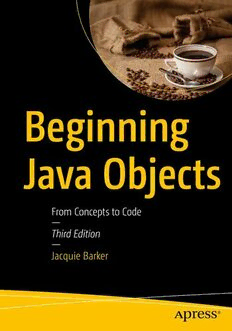
Beginning Java Objects: From Concepts to Code, 3rd Edition PDF
02023·12.378 MB·English
Most books are stored in the elastic cloud where traffic is expensive. For this reason, we have a limit on daily download.
Preview Beginning Java Objects: From Concepts to Code, 3rd Edition
Description:
As a programming language, Java's object-oriented nature is key to creating powerful, reusable code and applications that are easy to maintain and extend. That being said, many people learn Java syntax without truly understanding its object-oriented roots, setting them up to fail to harness all of the power of Java. This book is your key to learning both!This new third edition of Beginning Java Objects: From Concepts to Code discusses Java syntax, object principles, and how to properly structure the requirements of an application around an object architecture. It is unique in that it uses a single case study of a Student Registration System throughout the book, carrying the reader from object concepts, to object modeling, to building actual code for a full-blown application. A new chapter covers a technology-neutral discussion of the principles of building a three-tier architecture using Java, introducing the notion of model layer – presentation layer – data layer separation.Time and again, I meet software developers—at my place of employment, at clients’ offices, at professional conferences, on college campuses—who have attempted to master an object-oriented programming language (OOPL) like Java by taking a course in Java, reading a book about Java, or installing and using a Java integrated development environment (IDE) such as Eclipse, IntelliJ IDEA, NetBeans, or BlueJ. However, there is something fundamentally missing from virtually all of these approaches: a basic understanding of what objects are all about and, more importantly, knowledge of how to structure a software application from the ground up to make the most of objects.If you’re already experienced with the Java language (but not with object fundamentals), it’s critical to your successful use of the language that you learn about its object-oriented roots. On the other hand, if you’re a newcomer to Java, then this book will get you properly “jump-started.” Either way, this book is a “must-read” for anyone who wishes to become proficient with an OO programming language like Java.Coding examples used throughout the book are Java version-neutral. The core object-oriented principles that you will learn from this book are timeless, and are relevant to all versions of the Java language, as well as to many other object-oriented languages.The book can be used for individual self-study or as a university-level textbook.What You Will Learn:Know basic object-oriented principles, from the simplest notion of classes and objects through the power of encapsulation, abstract classes, and polymorphismApproach the requirements for an application to structure it properly around objectsRender the resultant object model into Java code, building a complete functioning model layer for the Student Registration System case studyConceptually round out an object layer by adding presentation and data layersWho This Book Is For:Software developers who have never tackled Java as a programming language, as well as those who have already used Java but want to ensure that they are taking full advantage of the object-oriented nature of the language.Even if you’ve already developed a full-fledged Java application, it’s certainly not too late to read this book if you still feel fuzzy when it comes to the object aspects of structuring an application; it ultimately makes someone a better Java programmer to know the “whys” of object orientation rather than merely the mechanics of the language. You’ll most likely see some familiar landmarks (in the form of Java code examples) in this book, but will hopefully gain many new insights as you learn the rationale for why we do many of the things that we do when programming in Java (or any other OO programming language for that matter).Because this book has its roots in courses that I teach at the university level, it’s ideally suited for use as a textbook for a semester-long university or advanced placement high school course in either object modeling or Java programming.
See more
The list of books you might like
Most books are stored in the elastic cloud where traffic is expensive. For this reason, we have a limit on daily download.
